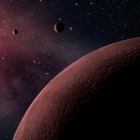Characterizing Planetary Systems Orbiting Low-mass Stars
Abstract: Over the past twenty years, ground- and space-based investigations have revealed that our galaxy is teeming with planetary systems and that Earth-sized planets are common. Although Earth-size planets within the habitable zones of Sun-like stars are challenging to detect, potentially habitable planets orbiting low-mass dwarfs are more amenable to detection due to their deeper transit depths, larger radial velocity semi-amplitudes, increased likelihoods of transit, and shorter orbital periods. We are now searching for these nearby, potentially habitable worlds by obtaining near-infrared spectra with IRTF/SpeX and Palomar/TripleSpec to characterize the population of K2 planet candidates orbiting low-mass stars. Many K2 targets are poorly characterized, so follow-up observations are crucial for identifying false positives and determining accurate planet radii. As of September 2016, we have observed over 100 K2 candidate planetary systems, half of which include candidates with initial radius estimates smaller than two Earth radii. I will present our resulting catalog of refined system properties and compare the population of K2 planetary systems orbiting low-mass stars to those detected by the original Kepler mission. Finally, I will address the implications for the expected yield of M dwarf planetary systems from the Transiting Exoplanet Survey Satellite and discuss the prospects for detailed follow-up investigations with Hubble, Spitzer, JWST, and the next generation of extremely large ground- and space-based telescopes.

